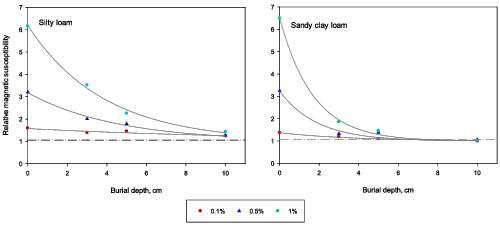当前位置:
X-MOL 学术
›
Earth Surf.Process. Land.
›
论文详情
Our official English website, www.x-mol.net, welcomes your feedback! (Note: you will need to create a separate account there.)
Assessment of magnetite as a magnetic tracer for sediments in the study of ephemeral gully erosion: Conditioning factors of magnetic susceptibility
Earth Surface Processes and Landforms ( IF 3.3 ) Pub Date : 2021-01-17 , DOI: 10.1002/esp.5074 Elena Zubieta 1 , Juan C. Larrasoaña 2 , Alaitz Aldaz 1 , Javier Casalí 1 , Rafael Giménez 1
Earth Surface Processes and Landforms ( IF 3.3 ) Pub Date : 2021-01-17 , DOI: 10.1002/esp.5074 Elena Zubieta 1 , Juan C. Larrasoaña 2 , Alaitz Aldaz 1 , Javier Casalí 1 , Rafael Giménez 1
Affiliation

|
In gully erosion, the detached soil can be transported over long distances along the landscape. The eroded material can be redistributed and/or deposited on the soil surface along the landscape and then eventually be buried by newly eroded and deposited sediment. There can be significant variability of the soil conditions (e.g., texture and moisture content) over which the eroded material travels. The eroded material can be detected through the use of magnetic tracers attached to or mixed with the eroded soil. In this study we evaluated the degree to which the magnetic signal of the magnetite is conditioned by (i) burial depth of tracer, (ii) condition of soil covering the tracer and (iii) tracer concentration. In the laboratory containers were filled with a specific soil. In the filling process, a 0.5-cm layer of a soil–magnetite mixture was interspersed in the soil profile at a certain depth. Experiments encompassed three different soil–tracer concentrations (1000:1, 200:1, 100:1), four burial depths of tracer (0 cm, 3 cm, 5 cm and 10 cm from soil surface), and two different soils. In each case, the magnetic susceptibility was measured with a susceptometer. Experiments were repeated with different soil moisture contents. If the tracer is located under the soil surface, a minimum soil–tracer concentration of 200:1 is required for its correct detection. The intensity of the magnetic signal decreases dramatically with the vertical distance of the tracer from the soil surface. The maximum detection depth for the tracer's magnetic signal is strongly dependent on the natural magnetic susceptibility of the soil, which masks the tracer's signal. Variation in soil moisture content does not significantly affect the magnetic signal. For extensive field studies, the soil–tracer volume to be handled would be very high and therefore, it is necessary to explore new tracer application techniques.
中文翻译:

在临时河道侵蚀研究中评估磁铁矿作为沉积物的磁示踪剂:磁化率的调节因素
在沟壑侵蚀中,疏离的土壤可以沿着景观远距离运输。侵蚀的物质可以沿着景观重新分布和/或沉积在土壤表面,然后最终被新侵蚀和沉积的沉积物掩埋。被侵蚀的材料所经过的土壤条件(例如质地和水分含量)可能存在很大的差异。侵蚀的物质可以通过使用附着在侵蚀土壤上或与侵蚀土壤混合的磁示踪剂进行检测。在这项研究中,我们评估了磁铁矿的磁信号受(i)示踪剂的埋藏深度,(ii)覆盖示踪剂的土壤条件和(iii)示踪剂浓度的调节程度。在实验室的容器中装有特定的土壤。在填充过程中,为0。5厘米厚的土壤-磁铁矿混合物层散布在一定深度的土壤剖面中。实验包括三种不同的土壤-示踪剂浓度(1000:1、200:1、100:1),四种示踪剂埋藏深度(距土壤表面0 cm,3 cm,5 cm和10 cm)以及两种不同的土壤。在每种情况下,用磁化率计测量磁化率。在不同的土壤水分含量下重复进行实验。如果示踪剂位于土壤表层以下,则要正确检测,最低示踪剂浓度应为200:1。磁信号的强度随着示踪剂与土壤表面的垂直距离而急剧下降。示踪剂磁信号的最大检测深度在很大程度上取决于土壤的自然磁化率,这掩盖了示踪剂的' 的信号。土壤含水量的变化不会显着影响磁信号。对于广泛的现场研究,要处理的土壤-示踪剂的体积将非常高,因此,有必要探索新的示踪剂应用技术。
更新日期:2021-01-17
中文翻译:

在临时河道侵蚀研究中评估磁铁矿作为沉积物的磁示踪剂:磁化率的调节因素
在沟壑侵蚀中,疏离的土壤可以沿着景观远距离运输。侵蚀的物质可以沿着景观重新分布和/或沉积在土壤表面,然后最终被新侵蚀和沉积的沉积物掩埋。被侵蚀的材料所经过的土壤条件(例如质地和水分含量)可能存在很大的差异。侵蚀的物质可以通过使用附着在侵蚀土壤上或与侵蚀土壤混合的磁示踪剂进行检测。在这项研究中,我们评估了磁铁矿的磁信号受(i)示踪剂的埋藏深度,(ii)覆盖示踪剂的土壤条件和(iii)示踪剂浓度的调节程度。在实验室的容器中装有特定的土壤。在填充过程中,为0。5厘米厚的土壤-磁铁矿混合物层散布在一定深度的土壤剖面中。实验包括三种不同的土壤-示踪剂浓度(1000:1、200:1、100:1),四种示踪剂埋藏深度(距土壤表面0 cm,3 cm,5 cm和10 cm)以及两种不同的土壤。在每种情况下,用磁化率计测量磁化率。在不同的土壤水分含量下重复进行实验。如果示踪剂位于土壤表层以下,则要正确检测,最低示踪剂浓度应为200:1。磁信号的强度随着示踪剂与土壤表面的垂直距离而急剧下降。示踪剂磁信号的最大检测深度在很大程度上取决于土壤的自然磁化率,这掩盖了示踪剂的' 的信号。土壤含水量的变化不会显着影响磁信号。对于广泛的现场研究,要处理的土壤-示踪剂的体积将非常高,因此,有必要探索新的示踪剂应用技术。


























 京公网安备 11010802027423号
京公网安备 11010802027423号